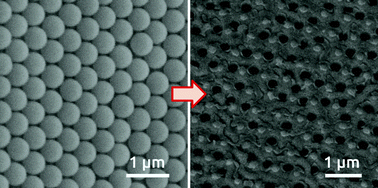Репрезентативные публикации за май 2018 г.
I. Mínguez-Bacho,a F. Scheler,a P. Büttner,a K. Bley,b N. Vogel*b and J. Bachmann, Ordered nanopore arrays with large interpore distances via one-step anodization, Nanoscale, 2018,10, 8385-8390, doi: 10.1039/C8NR02215A
Создание структурированных подложек из оксида алюминия с использованием технологий "снизу вверх", совместимых с приложениями нанотехнологий, по-прежнему является актуальной проблемой. Мы представляем новый подход для создания высокоупорядоченных структур в анодированном оксиде алюминия с большими расстояниями между нанопорами с помощью прямого одноэтапного процесса анодирования. Использование прозрачных изоляторов делает такие анодные слои применимыми в качестве шаблонов для наноструктурированных фотовольтаических или фотоэлектрохимических устройств.
Abstract
Preparation of pre-patterned alumina substrates using bottom-up techniques compatible with nanotechnology applications is still a challenge. We present a novel methodology to achieve superior order in ‘anodic’ alumina with large interpore distances by a convenient one-step anodization process. The use of transparent insulators renders such anodic layers applicable as templates for nanostructured photovoltaic or photoelectrochemical devices.
K.S. Kisel, T. Eskelinen, W. Zafar, P. Hirva, E.V. Grachova, S.P. Tunik, I.O. Koshevoy Chromophore-functionalized phenanthro-diimine ligands and their Re(I) complexes, Inorg. Chem., (2018), doi: 10.1021/acs.inorgchem.8b00422
Синтезирован ряд дииминовых лигандов на основе 2-пиридил-1Н-фенантро[9,10-d]имидазола (L1, L2). Связывание основного мотива L1 с антраценсодержащими фрагментами дает бихромофорные соединения L3-L5, из которых L4 и L5 принимают донор-акцепторную архитектуру. L1-L5 показывают сильную флуоресценцию в жидкой среде, демонстрируют обратимый отклик на изменение pH, для L4 и L5 наблюдается эмиссионный сольватохромиз. Лиганды L1-L5 использовали для синтеза соответствующих комплексов Re(I), которые демонстрируют необычную двойную эмиссию синглетного и триплетного происхождения.
Abstract
A series of diimine ligands has been designed on the basis of 2-pyridyl-1 H-phenanthro[9,10- d]imidazole (L1, L2). Coupling the basic motif of L1 with anthracene-containing fragments affords the bichromophore compounds L3-L5, of which L4 and L5 adopt a donor-acceptor architecture. The latter allows intramolecular charge transfer with intense absorption bands in the visible spectrum (lowest λabs 464 nm (ε = 1.2 × 104 M-1 cm-1) and 490 nm (ε = 5.2 × 104 M-1 cm-1) in CH2Cl2 for L4 and L5, respectively). L1-L5 show strong fluorescence in a fluid medium (Φem = 22-92%, λem 370-602 nm in CH2Cl2); discernible emission solvatochromism is observed for L4 and L5. In addition, the presence of pyridyl (L1-L5) and dimethylaminophenyl (L5) groups enables reversible alteration of their optical properties by means of protonation. Ligands L1-L5 were used to synthesize the corresponding [Re(CO)3X(diimine)] (X = Cl, 1-5; X = CN, 1-CN) complexes. 1 and 2 exhibit unusual dual emission of singlet and triplet parentage, which originate from independently populated 1ππ* and 3MLCT excited states. In contrast to the majority of the reported Re(I) carbonyl luminophores, complexes 3-5 display moderately intense ligand-based fluorescence from an anthracene-containing secondary chromophore and complete quenching of emission from the 3MLCT state presumably due to the triplet-triplet energy transfer (3MLCT → 3ILCT).

Scheer M., Braese J., Schinabeck A., Bodensteiner M., Yersin H., Timoshkin A.Y. Gold(I) Complexes Containing Phosphanyl- and Arsanylborane Ligands, Chem. Eur. J., 2018, 24, 10073–10077, doi: 10.1002/chem.201802682
Синтезированы и структурно охарактеризованы комплексы золота (I) с фосфанил- и арсанилборанами. Некоторые соединения проявляют люминесценцию. Электронная структура комплексов проанализирована методами DFT.
Abstract
The structural and photophysical properties of a series of new Au(I) compounds have been studied. The reactions of AuCl(tht) with the phosphanyl‐ and arsanylboranes RR'EBH2NMe3 (E = P, As; R = H, Ph; R' = H, Ph, tBu) afford the complexes [AuCl(RR'EBH2NMe3)]. In the solid state, [AuCl(H2PBH2NMe3)]2 (2a) is a dimer showing unsupported intermolecular aurophilic interactions with short Au…Au distances. In contrast, [AuCl(H2AsBH2NMe3)]n (2b) aggregates to form 1D chains. Organic substituents on the pnictogen atoms lead to discrete molecules in [AuCl(RR'PBH2NMe3)] (2c: R = H, R' = tBu; 2d: R = R' = Ph). To increase the aurophilicity, the ionic homoleptic complexes [Au(RR'EBH2NMe3)2][AlCl4] (3a‐d) have been synthesized for which 3a,b form chains in the solid state and exhibit luminescence. The emissions show a drastic red shift with temperature decrease correlating with decreasing Au...Au distances. DFT calculations provide insight into the bonding situation of the products.




